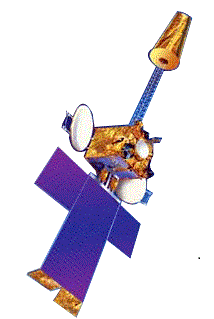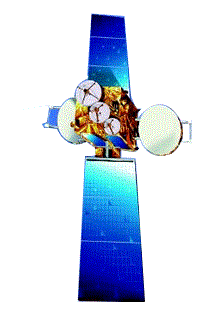
The Indian National Satellite System or INSAT, is a series of multipurpose geostationary satellites launched by the Indian Space Research Organisation (ISRO) to satisfy telecommunications, broadcasting, meteorology, and search and rescue operations. Commissioned in 1983, INSAT is the largest domestic communication system in the Indo-Pacific Region. It is a joint venture of the Department of Space, Department of Telecommunications, India Meteorological Department, All India Radio and Doordarshan. The overall coordination and management of INSAT system rests with the Secretary-level INSAT Coordination Committee.

Geosynchronous Satellite Launch Vehicle (GSLV) is a class of expendable launch systems operated by the Indian Space Research Organisation (ISRO). GSLV has been used in fifteen launches since 2001.
GSAT-3, also known as EDUSAT, was a communications satellite which was launched on 20 September 2004 by the Indian Space Research Organisation. EDUSAT is the first Indian satellite built exclusively to serve the educational sector. It is mainly intended to meet the demand for an interactive satellite-based distance education system for the country.
The Ariane Passenger PayLoad Experiment (APPLE), was an experimental communication satellite with a C-Band transponder launched by the Indian Space Research Organisation on June 19, 1981, by Ariane, a launch vehicle of the European Space Agency (ESA) from Centre Spatial Guyanais near Kourou in French Guiana.

The GSAT satellites are India's indigenously developed communications satellites, used for digital audio, data and video broadcasting. As of 5 December 2018, 20 GSAT satellites manufactured by ISRO have been launched, out of which 14 are in service.
GSAT-1 was an experimental communications satellite launched aboard the maiden flight of the GSLV rocket. The spacecraft was equipped with instrumentation to test Pulse-code modulation (PCM) transmitting on S-band frequencies and transponders operating in the C-band. The spacecraft was unable to complete its mission after a launch failure left it in a lower than planned orbit and propulsion issues prevented the satellite from correcting this via its own maneuvering system.

The Launch Vehicle Mark-3 or LVM3 is a three-stage medium-lift launch vehicle developed by the Indian Space Research Organisation (ISRO). Primarily designed to launch communication satellites into geostationary orbit, it is also due to launch crewed missions under the Indian Human Spaceflight Programme. LVM3 has a higher payload capacity than its predecessor, GSLV.

GSAT-4, also known as HealthSat, was an experimental communication and navigation satellite launched in April 2010 by the Indian Space Research Organisation on the maiden flight of the Geosynchronous Satellite Launch Vehicle Mk.II rocket. It failed to reach orbit after the rocket's third stage malfunctioned. The third stage was the first Indian-built cryogenic-fuelled upper stage, and was making its first flight. The ISRO suspects that the failure was caused by the third stage not igniting.

INSAT-3A, a multipurpose satellite built by ISRO was launched by Ariane in April 2003. It is located at 93.5 degree East longitude. It is third satellite in INSAT-3 series after INSAT-3B & INSAT-3C. Built at a cost of $53 mn, it provides communication, weather, and search and rescue services.

INSAT-3C is a multipurpose satellite built by ISRO and launched by Arianespace in Jan 2002. INSAT-3C is the second satellite of the INSAT-3 series. All the transponders provide coverage over India. Insat-3C is controlled from the Master Control Facility at Hassan in Karnataka. It will provide voice, video and digital data services to India and neighboring countries.
GSAT-5P, or GSAT-5 Prime, was an Indian communications satellite which was lost in a launch failure in December 2010. Part of the Indian National Satellite System, it was intended to operate in geosynchronous orbit as a replacement for INSAT-3E.
INSAT-4CR was a communications satellite operated by ISRO as part of the Indian National Satellite System. Launched in September 2007, it replaced the INSAT-4C satellite which had been lost in a launch failure the previous year. The satellite was initially stationed in geostationary orbit at a longitude of 74 degrees east, with expected operational life of at least ten years, however this may have been reduced by the underperformance of the Geosynchronous Satellite Launch Vehicle which placed it into orbit. INSAT-4CR is planned to be replaced by GSAT-31, which was launched on February 6, 2019.
GSAT-14 is an Indian communications satellite launched in January 2014. It replaced the GSAT-3 satellite, which was launched in 2004. GSAT-14 was launched by a Geosynchronous Satellite Launch Vehicle Mk.II, which incorporated an Indian-built cryogenic engine on the third stage.

INSAT-4E, also known as GSAT-6, is a member of the INSAT family and is a multimedia communication satellite that will offer a Satellite Digital Multimedia Broadcasting (S-DMB) service across several digital multimedia terminals or consoles which can be used to provide information services to vehicles on the fly and to the mobile phones. The satellite can be used for other social and strategic applications.
GSAT-7 or INSAT-4F is a multi-band military communications satellite developed by the Indian Space Research Organisation. The Indian Navy is the user of the multi-band communication spacecraft, which has been operational since September 2013. According to defense experts, the satellite will enable the navy to extend its blue water capabilities and stop relying on foreign satellites like Inmarsat, which provide communication services to its ships.
INSAT-4B was an Indian communications satellite which forms part of the Indian National Satellite System. Launched in 2007, it was placed in geostationary orbit at a longitude of 93.48° East.

GSAT-19 is an Indian communications satellite launched by the Indian Space Research Organisation aboard an LVM3 on 5 June 2017.

GSAT-6A was a communication satellite launched by the Indian Space Research Organisation (ISRO). It featured a 6-metre (20 ft) unfurlable S-band antenna similar to the one used on GSAT-6. Around 17 minutes after lift-off, the three stage GSLV Mk.II rocket flying on GSLV F08 mission successfully injected the satellite into a geosynchronous transfer orbit. Due to power failure during its orbit raising burns the communication was lost with GSAT-6A before it could reach its final circular geostationary orbit (GSO).

GSAT-29 is a high-throughput communication satellite developed by the Indian Space Research Organisation (ISRO). The mission aims at providing high-speed bandwidth to Village Resource Centres (VRC) in rural areas. The two Ku and Ka operational payloads will provide communication services to Jammu and Kashmir and Northeast India under Digital India programme. At the time of launch GSAT-29 was the heaviest satellite, weighing 3,423 kg (7,546 lb), that was placed in orbit by an Indian launch vehicle. Approved cost of GSAT-29 is ₹175.63 crore (US$20 million).
CMS-02 is an Indian Communication Satellite built by ISRO. The CMS-02 satellite is funded, owned and operated by New Space India Limited. Cost of spacecraft was around ₹400 crore. The entire capacity onboard CMS-02 satellite will be leased to Tata Play. The satellite was placed into orbit by using Ariane 5 rocket.












